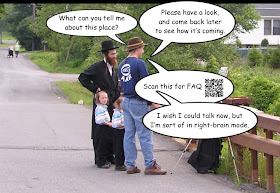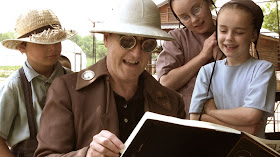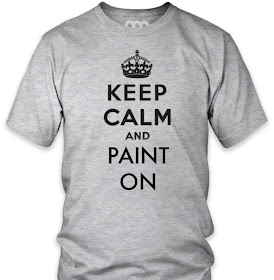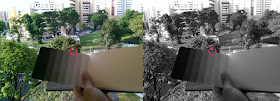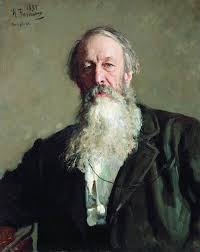 |
Carl Larsson -- Plein Air Painter, Winter-Motif from Åsögatan, Stockholm, 1886
|
Phil Mamuyac
"He's a drawer!"
Anath Sheridan
"I can't draw a straight line" is another... Always want to say "well neither can I, do you SEE that horizon line?!"
Timothy Atkins
"What are you doing?"
"Playing tennis" is my usual half joking/half snide answer. After all, you never know who you are talking to!
I actually really enjoy interacting with people on the street, especially kids, but they have a tendency to turn up just when you're 3 seconds in to an important watercolor wash. And then all is lost.
I liken it to someone walking up to a DJ and ripping the needle of the record, only to ask "are you playing music?" and then you're left to find the exact spot on the record again.
Kathy Partridge
How long does it take you? Do you do sheeps? (Yes, "sheeps"!)
Arun VB
LOL ! "I can't draw a straight line" is very typical and usual question
Thomas Gieseke
HA! I did a fundraiser at Zoo Atlanta in June where a bunch of us worked plein air and the profits went to the zoo. A lot of the artists had never worked in such a public forum before and we got lots of stories. The camp groups and patrons were overwhelming but also very complimentary. (Although I did end up with a child mostly sitting in my lap at one point!)
Phil Moss
'My sister's friend's brother's third cousin twice removed is studying art at university, you should meet him!' No, it's fine, really!
Sara Otterstätter
Are those people Mennonites? And one particular story came to my mind:
I was at the local zoo, sketching the rhinocerosses - their anatomy is a nightmare - and in a short distance was an older lady with her grandson. She may have thought that it is better not to talk to me because I might be disturbed while fighting with the awkward rhinoceros-anatomy. So she talked with her grandson about me. But hell, in what way.
"Oh look how nice this lady draws! Does she not draw nicely?! Shall I pick you up that you can see how nicely the lady draws?!....." I really felt like I was merely an drawingmonkey at the zoo and wished she had talked to me instead of over my head. Maybe I should get a "Do not feed the Artist"-sign and put it next to me the next time I am at the zoo sketching.
Simon Schmidt
100% hit. Also the age distribution is nearly perfect. Usually there are a few more elderly people.
Eric Wilkerson
My favorite is from a time I was painting with
Garin down by the hudson. A man came up and said to him "If it comes out good I'll give you a hundred bucks for it".
Harmony Baudelaire Carrigan
"I can't even draw a straight line" and "I can't even draw stick figures" are the two I always hear.
Laslo Iera
That's exactly why I am afraid of painting in public. I'm deaf and that would definitely make an awkward situation where I would have to spend more energy on explaining the fact that I can't hear and have less energy for actual painting time. Awkward, I tell ya... but I guess it's also awkward in your world, having all people watch you painting and have those questions that shouldn't have been asked in the first place. Lol.
Andy Volpe ·
"Oh, can't you let my child/ren draw on the corner of your paper?! They're Master Artists themselves!". It's true, it takes a lot of energy and patience to work in front of the public…A…Lot. But for the most part comments and questions are fairly descent and genuinely curious. It's similar to reenacting/living history, and that "You're wearing wool?! Aren't you HOT in all of that?!" No, I'm pouring sweat because I'm cold….
Andy Volpe ·
I feel really bad for that Spanish artist trying to paint, I've never seen anything like that. It makes me wonder now if the Old Masters who painted outdoors scenes where there's only 2-3 people in the painting, had dozens of onlookers standing behind them that we don't see.
Jasper Patch "that looks good. What is it ?"
"are you painting that?"
Eran Fowler ·
I always get the stick figure comment. Usually accompanied with "I could never in a million years." Makes me wonder if they were too afraid to ever try.
I love painting in public. It's where a lot of my sales comes from. I usually get the request: "Can I be in your painting?" I usually tell them "Sure... if you are willing to stand there for about 1/2 hour or more". I'm sure that, one day, someone will take me up on that!
Shenge Bana Gon Paja ·
Just smile
Ulrich Zeidler
Still trying to figure out what people mean when they say "Are you an artist?"
Barry Van Clief ·
Mostly people are friendly and pleasant, perhaps many of them would like to do art themselves. I've always thought plein air painting would be a good way to generate sales, if I were less shy and did it more often.
Joe Nazzaro
...yep...and ...when i set up at an art festival...i have my work on display...people like to ask ..'did you draw all these..?"..."..."...why yes i did"...."Dang!!...you're good.."...the tell me about a relative who draws or paints..."they ain't as good as you, but they're pretty good".....and then they walk away....
Richard Smith
I know I love it. "I can't even draw a straight line"... "no you don't understand I can't draw, I've tried."
I always tell people "good, if it were a straight line it wouldn't be art."
And as for not being able to draw or paint, I usually just say " the only reason you 'can't' is because you simply 'don't'. I try to encourage people..."You could draw or paint as well or better if you'd practice as much. It's not a magical power...talent = desire + discipline".
The world can never have enough artists
Weston Hobdy ·
"I saw a TV program on Ansel Adams a few nights ago, but you.... you do these freehand, don't you?"
Tim Vedel ·
when you blast a wall at 3 am with a spray can people usually keep their mouths shut hahah
Karalyn Johnson
Them, "I can't even draw a straight line!" Me, " Me either, that's why I use a ruler."
Greg Newbold "did you just start that today?" Yea, like an hour ago. "How much would you sell that for?" In the gallery, about $900. "Yea, right. Good luck with that." Thank you for watching.
Carlos Castañón ·
I had a guy stand behind me for some solid 45 minutes, claiming he "just loves the smell of turpentine".
Danielle Nicole De Shane I still get a crack out of the people asking, "Did you draw that?" While you're in the middle of drawing. My friend had responded with this shocked expression, "OH MY GOD, what's this!? I didn't draw this! How did this get here!? My hand has a mind of it's own!"
Shannon Beaumont
At the Munich zoo people ask "Did you make that yourself?"... I usually say to them "Nope, bought it on Amazon.com..."
Jenny Wolfe First time I was plein air painting a lady stopped her truck in the middle of the dirt road, ran out, and asked "Can I have that? For free? My neighbors would adore that in my house!" Of course I said no, and told her her neighbors could adore it from where I'm painting. Some people.
Mervin LovesZbrush
I get lookers all the time at coffee shops. It turns up the pressure to perform lol
John Cullen
I don't mind curious spectators. If someone comes up to me and asks me 'did you draw that?' (while I'm in the middle of drawing something), I don't belittle them or talk down to them for doing so. They are merely showing curiosity in what you're doing.
Remember that it can be scary for people to approach and talk to complete strangers, so saying things such as 'did you draw that?' or 'I couldn't draw a straight line to save my life' are just easy ways for them to attempt to break the ice. It's the equivalent of starting a conversation with 'how about that weather?'
Yes, it can get a little annoying at times, but people mean absolutely no offense when they try talking to you. The amount of snide and stuck up comments here about such people truly disappoints me.
Patti Glynn Haarz
I am a magnet...that is one of the reasons I don't like plain air. However, I have always wanted to turn around quickly and say, "you can see me!!!" with a wild look in my eye or perhaps a tick.
David Cameron had most of those. I had a young lad say to me once,' wow did you draw that? do you know what, you should become a real artist'!!!
Eric Wolf
No, since I can't paint. But I do get similar comments when practicing archery or when reciting my poems to my girlfriend.
Chithra Mitra can add one more...." can u teach my 4 year old son,tony.......he paints exactly like u "!!! ...lols
Aline Schleger In art school (of all places) I was "in the zone" when I noticed some first years checking as I drew with pastels. I was shocked when turning around an hour after and still see them there (was wearing headphones). I blushed.
Lyn Lull oh yeah heard 'em all and more
Harvey McDowell "never show a fool a thing half finished"........
Cliff Cramp I got, "my 5 year old daughter is an artist too."
Mike Kloepfer
Currently, 'Stick Figures' is tied with 'I can do that.'
My stock response: "I'll tell you a secret. My stick figures are terrible."
Angela Bell
lol I've had the stick figure comment so many times I've lost count. I also had neck-craners when I was sketching on a train, this lasses head almost fell off trying to see who on the train I was sketching whilst I tried my best to ignore her, then I realised after that she was holding a pose and looking to see if I was sketching her yet...I didn't.
Lyn Lull I took a workshop up in the White Mountains of NH last year. Trying to paint a waterfall and had a steady stream of tourists hiking by and saying many of those comments and many others like my friend, wife husband, cousin etc are artists too and they do this that or the other
Ricky Mujica
"If I give you a photograph, can you draw it?"
Susan Fox
you left out....
" my cousin is a natural artist, they never went to school for it "
Barb Cimity ·
Just proves art has a human connection for every person. We should cherish that.
Christopher Radko It's so rare to see ladies in dresses, these days....
Robert Paulmenn ·
i always think of myself as "public domain" when I'm on the street painting. I've had people purchase work on the spot, it's worth a little distraction from time to time.
Raven Amos
Every. Time. Or "'What is it?' (I tell them) 'Oh...it's cute' !"
Mike Kloepfer
It's a strange phenomenon, and I've had quite a bit of experience with it.
The way I look at it, most people never have the opportunity to see art being created. So I try to be engaging as possible.
Plus, It's not like they broke down the door of my studio. I put myself out there in public, doing something interesting. Most people are genuinely curious, and that's natural. It's counterproductive to be offended when they engage.
To the vast majority, the art-making process is a mystery, and there is a lot of 'myth' surrounding artists. So you get a lot of interesting, unusual, and sometimes totally unexpected comments. Some are downright hilarious.
For me, it really depends on the person, how they present themselves (some people are nice, some are just rude,) and other factors, like my concentration level, noise, weather conditions, etc. And sometimes I'm just not in a talkative mood. I'm human.
I've noticed that I'm not as talkative right after I've eaten. That's Mikey's quiet, inside-my-head, art-making time. LOL
It reminds me of something Jeff Watts said. (Paraphrasing....) Talking while making art is a unique skill. Some people like it, some don't.
Johnny Morrow
If I had a quarter for every time I heard, "I can't even draw a stick figure!" Oh man
Graham Nightingale
Hold on! you forgot the other inspiring comments James!!
What's that supposed to be?
You should see the stuff my kid paints its way better than that!
Nobody ever made money doing this son, why don' you get a proper job!
etc etc.
Mike Kloepfer Yes, Johnny - I could buy a lot more art supplies! LOL
Mike Kloepfer
I appreciate the idea that people are interested in art and artists, so I don't mind the comments. A sale or commission might result from any new human contact. I'm able to concentrate while carrying on a conversation, so it doesn't interfere with painting. Maybe I'll pick up a new student; maybe someone will buy my book.
If I want to paint without people around, I know a wild place that's full of rattlesnakes. They never bother me, and I don't bother them.
Peter Hoss
One of my favorites, "my aunt is an artist".
Leslie Jordan
That's funny. When I see an artist on the streets like that, I take a quick look and move on. I know they are in a creative zone and don't have time for interruptions, though if I saw you on the street, I would at the very least just say hi.
Andy Volpe
Leslie - Yeah, I try to just say a quick hello, take a quick peak and move on, knowing they're trying to work.
Andy Volpe
The one peeve I have is when I'm doing a demonstration (i.e. Printing) and trying to explain what it is I'm doing, and then someone decides they're going to cut in and explain it to someone else for me. "What are you doing?" I'm inking the plate "See? He's inking the plate!"
Tommy Scott
That face says, "kill me now."
Johanna Westerman ·
One reason I avoid it. Of course you say, "You realize who I am, don't you?"(haha)
Mike Kloepfer Wow, that guy in the video could sure use some traffic cones. LOL
I've got a plen air outing this weekend (which I am VERY excited about) and this got me to thinking about it. A lot. And a lot of good ideas came out of that thinking.
I posted at length about the subject in the comments on the blog post.
(Mikey said... "Wow. That guy sure could use some traffic cones. LOL " etc.)
Susan Rankin-Pollard
^I like the part of your comment where you suggest a liason. i do this at comic cons where I'm drawing so that I can actually do the work I've got in front of me and take more commissions. Helps A Lot!
Susan Rankin-Pollard When I draw in public, I take stock of how I'm feeling ahead of time and that determines where and how I sit. If I'm not open to chatting, i'll have my back to a corner. Most people are really good about respecting personal space. Earbuds/headphones help too, but I'll always talk to kids. To kids it's magic that they're willing to try without immediately tearing themselves down with I can'ts.
Monarchs Die
Why are you drawing this you should be drawing bla bla bla ... Coud you draw me? I have a school homework would draw things for me? Etc...
Mike Kloepfer Chithra Mitra
Maybe her son Tony's last name is Pro. You never know... LOL
Mike Kloepfer Susan - I agree. I was having this discussion with a fellow artist this weekend. We understand that what we do is applied skill, but to the lay-person, it has the same effect as a magic act.
Mike Kloepfer I'll try to gauge my mood and my audience, and if it's right, I'll go for the funny. However, I try to calibrate my humor to be entertaining, not insulting. I try to give them the same consideration I would like to receive.
(I've gotten pretty accurate, but even so, there's times... )
Mike Kloepfer
Geez, gang - there's some great stories and anecdotes here. Got so entertained, I almost forgot...
Time for me to get drawing!!!
Blanca Plata Ortega
What about this one: if I had money I will bay it from you! But I'm just a kid! LOL
Aline Schleger James, ever thought of putting a printed F.A.Q. somewhere near you? With pamplets pointing to your books,prints,etc?
Eric Bowman ·
Aren't you that guy who wrote Jurassic Park?
Reginald Atkins
yep.. several times. since taking up digital art and working on a tablet.. less so, since it's not as easy to see the entire thing over my shoulder as I focus on a small detail.
Arthur Machabee
If I had a nickel for every time someone asked "Did you draw that?" while I'm still drawing, I could buy a whole new set of art supplies (which I wouldn't mind having).
Ed Redgrove ·
Yep, all of them, also while lying in a park, had a grandmother drag her screeching kid towards me with "oh lets see what this man is drawing" a graphic sword fight was what... she did not appreciate it
Mike Kloepfer
My favorite is. did you trace that?
Ed Nickerson ·
How about : my friends daughter is an artist too, she won a ribbon for the art in her 3rd grade class last week.
Rebecca England ·
all the time!
Raphael Schnepf
